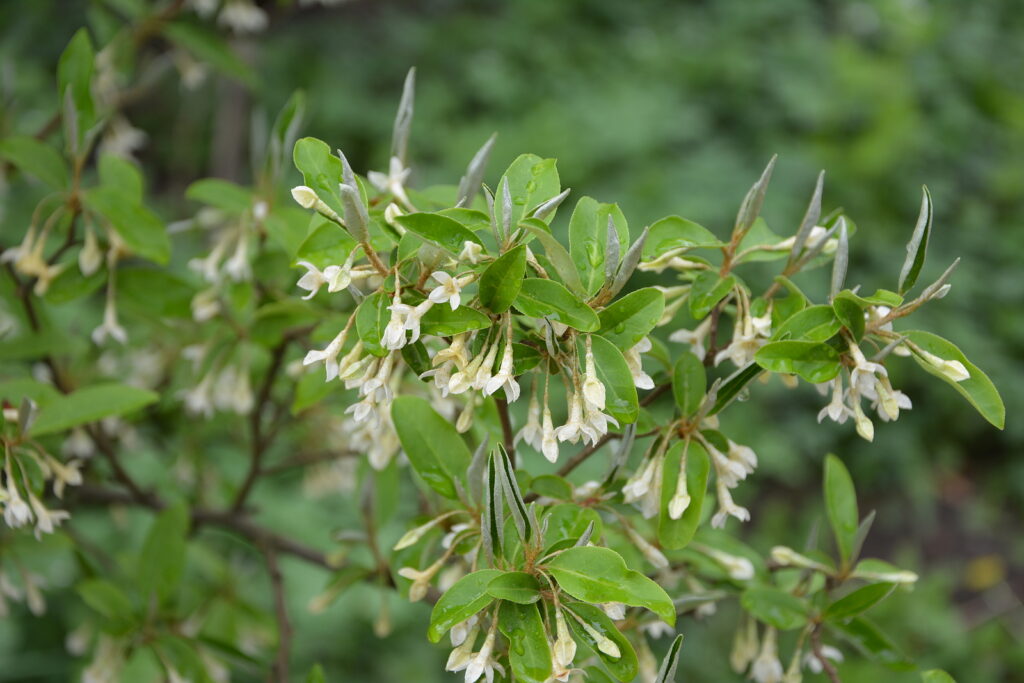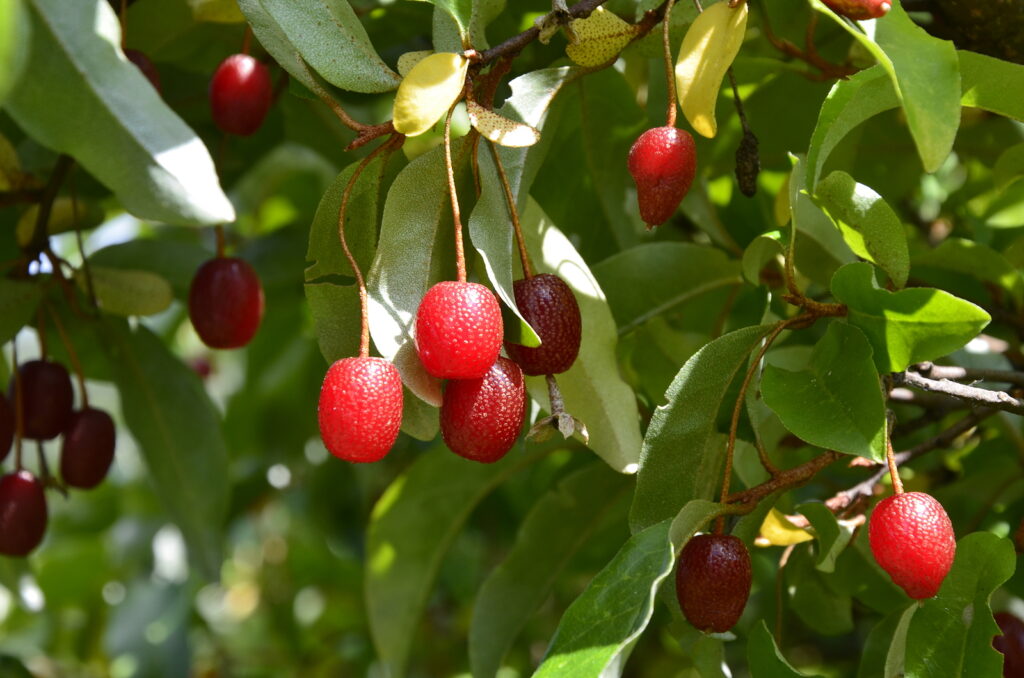Elaeagnus are fast-growing shrubs often used for hedges and screens. They are dense, full, and tough; they are upright and spreading growers that require little upkeep. Elaeagnus tolerate heat, wind, and seashore conditions. Established plants can withstand drought.
Grow Elaeagnus in shrub borders and also as specimen shrubs. Evergreen varieties are well-suited for hedges or screens. Many varieties have silvery-gray leaves. Evergreen varieties produce small, tubular often fragrant flowers in autumn.
Elaeagnus is a genus of about 45 species of deciduous or evergreen shrubs and small trees. Elaeagnus are native to thickets and dry places mainly in Asia, but a few are from Southern Europe and North America.

Get to know Elaeagnus
- Plant type: Deciduous, evergreen shrubs or small trees
- Growing zones and range: Zones 3 to 9 depending on the variety
- Hardiness: Hardy to Zone 3
- Height and width: As broad as they are tall; 10 to 15 feet (3-4.5m) tall and wide depending on the variety
- Growth rate: Fast
- Form and habit: Upright, spreading and rounded
- Foliage: Evergreen forms have silvery (sometimes brown) dots that cover leaves, reflecting sunlight to give plants a special sparkle; deciduous kinds have silvery-gray leaves
- Flowers: Small, insignificant, but usually fragrant flowers
- Fruits: Decorative, typically red with silver flecks
- Bloom time: Evergreen kinds bloom in fall; deciduous in early summer
- Uses: Borders, windbreaks, formal hedge, and seaside plantings, natural espaliers; all species make splendid screens
- Common name: Elaeagnus
- Botanical name: Elaeagnus
- Family name: Elaeagnaceae
- Origin: Primarily from Asia
Where to plant Elaeagnus
- Plant Elaeagnus in full sun or partial shade.
- Plant Elaeagnus in well-drained soil; will tolerate dry, salty soil.
- Elaeagnus can become chlorotic in highly alkaline soil.
- Elaeagnus can tolerate seashore conditions, heat, and wind.

When to plant Elaeagnus
- Set container-grown Elaeagnus in the garden in spring or autumn.
- Sow seed in a cold frame in autumn.
Planting and spacing Elaeagnus
- Space Elaeagnus 10 to 15 feet (3-4.5m) apart; for hedges, plant E. anǵustifolia 3-5 feet (.9-1.5m) apart.
- Sow seed 1/4 inch deep in evenly prepared soil.
How to water and feed Elaeagnus
- Give Elaeagnus regular to little water.
- Established Elaeagnus plants will tolerate considerable drought.
- Feed Elaeagnus with an all-purpose organic fertilizer in spring.

How to prune and care for Elaeagnus
- Elaeagnus rarely needs pruning, except to remove solid green branches on variegated selections; tolerates close shearing.
Elaeagnus pests and diseases
- Cankers, dagger nematode, dieback, rust, fungal leaf spots, and root rot occur.
Elaeagnus propagation
- New Elaeagnus can be started from softwood cuttings of young growth in late spring or early summer, from semi-hardwood cuttings of more mature growth in mid- or late summer, or from hardwood cuttings of dormant leafless growth in fall and winter.
- Elaeagnus can also be grown by forcing a branch to grow roots by the method known as ground layering.
- Sow seed in a cold frame in autumn.

Elaeagnus varieties to grow
- Elaeagnus anǵustifolia, Russian olive, oleaster, has slender 1.5-3.5 inch (3.8-8.9cm) silvery-gray leaves and ordinarily becomes a many-branched 12-15 feet (3.7-4.6m) shrub, although if lower branches are removed to leave one main stem, it may grow into a small tree 20 feet (6.1m) tall. It can be grown as a formal hedge because it will tolerate close shearing. It is a mainstay in windbreak plantings on the high plains of western Canada and the United States. Old plants have crooked picturesque trunks with loose brown bark. The tiny yellow fragrant flowers bloom in early summer and are followed by .5 inch (1.3cm) yellow but silvery-scaled sweet berries in late summer and fall. Zones 2 to 9.
- E. arǵentea (E. commutata), Silverberry, Wolf willow, native from Alaska south to Utah and from the Pacific eastward to Quebec, grows 8-12 feet (2.4-3.7m) tall and has 1.5-2.5 inch (3.8-6.4cm) leaves that are silvery on both sides. It has inconspicuous but very fragrant yellow flowers in late spring, followed by .4 inch (1cm) silvery berries that last from midsummer to early fall. Zones 1 to 7.
- E. ebbingei (E. macrophylla ‘Ebbingei’), hybrid derived from E. pungens, evergreen shrub. More upright—to 10-12 feet (3.1-3.7m)—than its parent, with thornless branches. Leaves 2-4 inches (5.1-10.2cm) long, silvery on both sides when young, are later dark green above and silvery beneath. Tiny, fragrant, silvery flowers. Red fruit makes good jelly. ‘Gilt Edge’ has striking yellow margins on its leaves.
- E. multiflora (E. longipes), Cherry eleagnus, Gumi, a smog-resistant shrub that grows up to 9 feet (2.7m) tall and has .8 inch (2cm) fragrant pale yellow flowers in late spring. The flowers are followed by .5-.8 inch (1.3-2cm) red cherrylike fruits in early summer that are exceptionally attractive to birds. The leaves of the cherry eleagnus are 1.5-2.5 inches (3.8-6.4cm) long and are green above and silvery beneath. Zones 4 to 10.
- E. philippensis, Lingaro, evergreen shrub or vine. Resembles E. pungens, but with longer arching branches 9-15 feet (2.7-4.6m) long. Can be trained as a climber. Narrow, 2 inch (5.2cm) long leaves are silvery beneath. Exceptionally fragrant, .4 inch (1cm) pink fruits that can be made into jelly.
- E. pungens, Silverberry, large evergreen shrub. Has rather rigid, sprawling, angular habit of growth to height of 6-15 feet (1.8-4.6m); can be kept lower and denser by pruning. Even tolerates shearing into hedge. Grayish green, 1-3 inches (2.5-7.6cm) long leaves have wavy edges and brown tinting from rusty dots. Branches are spiny, also covered with rusty dots. Overall color of the shrub is olive drab. Oval fruit, .5 inch (1.3cm) long, red with silver dust. Tough container plant in reflected heat, wind. Variegated forms listed below are more widespread than the species and have a brighter, lighter look in the landscape; they are less hardy than the species, however, and may suffer cold damage in some Zones. Be sure to cut out growth that reverts to green. Effective barrier plantings: growth is dense and twiggy, and spininess is a help, yet plants are not aggressively spiny.
- E. umbellata, Autumn eleagnus, has tiny yellowish-white fragrant flowers in late spring and unusual berries—they are scaly, silvery brown in summer, and do not ripen to scarlet until mid-autumn. This species grows 12-15 feet (3.7-4.6m) tall and has 2-4 inches (5.1-10.2cm) leaves that are dark green above and silvery beneath; the tips of new growth are notably silvery also. Zones 3 to 8.
- E. ‘Coral Silver’, large shrub, evergreen some places, deciduous others, and sometimes partially deciduous elsewhere. Has unusually bright gray foliage, coral red berries in fall.



